Welcome to Study of the Week from Patient Worthy. In this segment, we select a study we posted about from the previous week that we think is of particular interest or importance and go more in-depth. In this story we will talk about the details of the study and explain why it’s important, who will be impacted, and more.
If you read our short form research stories and find yourself wanting to learn more, you’ve come to the right place.

This week’s study is…
Changes in Hydroxyurea Use Among Youths Enrolled in Medicaid with Sickle Cell Anemia After 2014 Revision of Clinical Guidelines
We previously published about this research in a story titled “Hydroxyurea is Recommended for Children with Sickle Cell Anemia. So Why Does It Remain Underused?” which can be found here. The study was originally published in the research publication JAMA Network Open. You can read the full text of the study here.
This research team was affiliated with the University of Michigan School of Public Health.
What Happened?
Hydroxyurea has been rigorously established as a primary, disease-modifying treatment for patients aged nine months or older who live with sickle cell anemia, a rare disease. However, in a recent study which sought to evaluate its use in Michigan and New York state among Medicaid recipients, hydroxyurea was not being used by a significant number of child patients. This is despite the fact that this therapy can reduce the risk of potentially life-threatening complications in people living with sickle cell anemia, such as stroke, early death, and pain crisis.
Hydroxyurea has been included in treatment guidelines for sickle cell anemia since 2014. The researchers looked at administrative data from the New York and Michigan Medicaid programs from the years 2010-2018. A total of 4,302 pediatric patients with the disease were included in the study. All of these patients were Medicaid enrollees for at least one year. The principal outcome of this study was use of hydroxyurea, which was defined as mean annual counts of days’ supply of prescriptions that were filled. In Michigan, the data indicated a mean yearly days’ supply of the drug of 47.2/patient in Michigan and 97.4 days/patient in New York.
Additionally, the team found that Michigan had an increase in the chance of having a nonzero days’ supply of hydroxyurea after the guidelines were released in 2014. However, the same change was not seen in New York. Still, the team did note promising trends that suggested increased use of the drug since the release of the guidelines. The team concluded that interventions to increase the use of hydroxyurea in pediatric patients are necessary, as this treatment can improve outcomes and quality of life for sickle cell anemia patients.
About Sickle Cell Anemia
Sickle cell anemia is a genetic, inherited disorder of the blood. This disorder is characterized by an abnormality affecting hemoglobin, which is found in red blood cells and is responsible for carrying oxygen. The abnormality causes blood cells to lose their typical circular shape and instead take on an elongated, sickle-like appearance. This is caused by a genetic mutation that may have arisen as a defense against malaria, although this benefit only occurs in people with sickle cell trait, not the disease. Symptoms begin to appear at around six months old and include swelling of the hands and feet, stroke, bacterial infections, and acute episodes of severe pain termed sickle cell crisis. Severity of disease varies, but these attacks can result in serious declines in health and organ damage. Treatment is mostly symptomatic, but bone marrow transplant has been curative in children. The disease most frequently affects people of African ancestry. Life expectancy is between 40 and 60. To learn more about sickle cell anemia, click here.
Why Does it Matter?
The research team was, unfortunately, not surprised by the results of this retrospective study. Lack of access to recommended interventions is widespread in people with sickle cell anemia:
“Although disappointing, this was not surprising. Our previous research showed that children with sickle cell anemia do not receive other essential, recommended preventive services at high rates. Specifically, less than one in 10 receive enough antibiotic prophylaxis in the year to protect against infection, and less than half receive screening for strokes. Despite changes in clinical guidelines to recommend hydroxyurea for all children with sickle cell anemia starting in 2014, the majority of youths did not receive this disease-modifying therapy.” – Sarah L. Reeves, PhD, MPH, Assistant Professor, Pediatrics and Epidemiology, University of Michigan School of Public Health
The scientists are calling for large-scale studies of implementation that includes input from families and patients. These studies could improve “uptake and sustainability of outcomes.”
Social determinants of health likely play an outsized role in the lack of hydroxyurea use. Since sickle cell anemia is more prevalent among people of African ancestry, this population is more likely to face institutionally racist barriers to treatment access.


